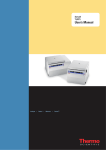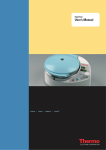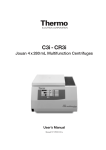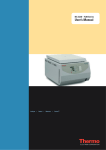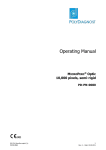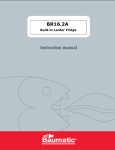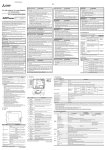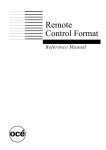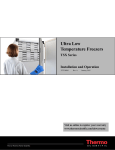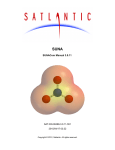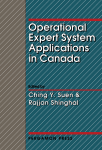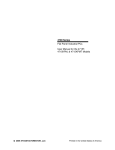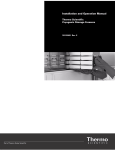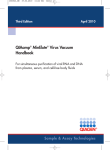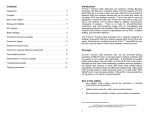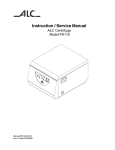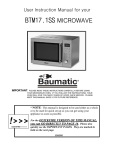Download User`s Manual
Transcript
Copertina 13-06-2006 12:15 Pagina 1 IEC CL31 - CL31R Multispeed User’s Manual Analyze • Detect • Measure • ControlTM Interno 13-06-2006 12:14 Pagina i IEC CL31 - CL31R Multispeed User’s Manual IEC CL31 - CL31R Multispeed Interno 13-06-2006 12:14 Pagina ii Carefully read this manual before operating your instrument. Information contained in this document is the property of Thermo Electron Corporation; it may not be duplicated or distribuited without the owner’s authorization. The validity of the guarantee is subject to the observation of the instructions and precautions described in this document. Interno 13-06-2006 12:14 Pagina iii Preface MANUAL NUMBER REV ECR/ECN DATE DESCRIPTION a 11290087 02/06 Initial release Thermo Electron Corporation BY IEC CL31 - CL31R i Interno 13-06-2006 12:14 Pagina iv Packing List 11210913 11210914 11210915 Centrifuge IEC CL31 Centrifuge IEC CL31 Centrifuge IEC CL31 230V 50/60 Hz 120V 60 Hz 100V 50/60 Hz 11210917 11210918 11210919 11210920 Centrifuge IEC CL31R Centrifuge IEC CL31R Centrifuge IEC CL31R Centrifuge IEC CL31R 230V 50/60 Hz 120V 60 Hz 100V 50 Hz 100V 60 Hz Item number 11290087 64227001 Quantity Check Centrifuge 1 User manual 1 Manual lid opening instructions 1 Mains cord 1 Toolbox: 11202979 Rotor removal tool 1 25535010 Emergency unlocking tool 2 26387032 Spare fuses (CL31 only) 1 For missing parts call your nearest Thermo representative ii IEC IEC CL31 - CL31R Thermo Electron Corporation Interno 13-06-2006 12:14 Pagina v WEEE Compliance Great Britain WEEE Compliance. This products is required to comply with the European Union’s Waste Electrical & Electronic Equipment (WEEE) Directive 2002/96EC. It is marked with the following symbol. Thermo Electron has contracted with one or more recycling/disposal companies in each EU Member State, and this products should be disposed of or recycling through them. Further information on Thermo Electron’s compliance with these Directives, the recyclers in your country, and information on Thermo Electron products which may assist the detection of substances subject to the RoHS Directive are available at www.thermo.com/WEEERoHS Deutschland WEEE Konformittät. Dieses Produkt muss die EU Waste Electrical & Electronic Equipment (WEEE) Richtlinie 2002/96ECerfüllen. Das Produkt ist durch folgendes Symbol gekennzeichnet. Thermo Electron hat Vereinbarungen getroffen mit Verwertungs-/Entsorgungsanlagen in allen EU-Mitgliederstaaten und dieses Produkt muss durch diese Firmen widerverwetet oder entsorgt werden. Mehr Informationen über die Einhaltung dieser Anweisungen durch Thermo Electron, die Verwerter und Hinweise die Ihnen nützlich sein können, die Thermo Electron Produkte zu identizfizieren, die unter diese RoHS Anweisung fallen, finden Sie unter www.thermo.com/WEEERoHS Italia Conformità WEEE. Questo prodotto deve rispondere alla direttiva dell’Unione Europea 2002/96EC in merito ai Rifiuti degli Apparecchi Elettrici ed Elettronici (WEEE). È marcato col seguente simbolo. Thermo Electron ha stipulato contratti con una o diverse società di riciclaggio/smaltimento in ognuno degli Stati Membri Europei. Questo prodotto verrà smaltito o riciclato tramite queste medesime. Ulteriori informazioni sulla conformità di Thermo Electron con queste Direttive, l’elenco delle ditte di riciclaggio nel Vostro paese e informazioni sui prodotti Thermo che possono essere utili alla rilevazione di sostanze soggette alla Direttiva RoHS sono disponibili sul sito www.thermo.com/WEEERoHS Espana WEEE Conformidad. Este producto requiere cumplir con la Directiva 2002/96EC WEEE (residuos de quipos electricos y electronicos). Este producto esta marcado con el simbolo WEEE, como se describe. En cada Estado Miembro de la Union Europea (EU), Thermo Electron ha contratado con diversas companias para disponer y/o re-ciclar los residuos de equipos electricos y electronicos. Existe information adictional acerca de la conformidad de Thermo Electron con esta Directiva, incluyendo los nombres de las diversas companias autorizadas para disponer/recyclar nuestros productos. Adicionalmente suministramos Thermo Electron Corporation IEC CL31 - CL31R iii Interno 13-06-2006 12:14 Pagina vi WEEE Compliance informacion acerca de los productos de Thermo Electron que puedes asistir en la deteccion de substancian mensionades en la directiva RoHS, explicado en www.thermo.com/WEEERoHS France iv IEC CL31 - CL31R Conformité WEEE. Ce produit doit être conforme à la directive européenne (2002/96EC) des Déchets d’Equipements Electriques et Electroniques (DEEE). Il est merqué par le symbole suivant. Thermo Electron s’est associé avec une ou plusieurs compagnies de recyclage dans chaque état membre de l’union européenne et ce produit devrait être collecté ou recyclé par celles-ci. Davantage d’informations sur la conformité de Thermo Electron à ces directives, les recycleurs dans votre pays et les informations sur les produits Thermo Electron qui peuvent aider le détection des substances sujettes à la directive RoHS sont disponibles sur www.thermo.com/WEEERoHS Thermo Electron Corporation Interno 13-06-2006 12:14 Pagina vii Declaration of compliance Declaration of compliance We, Thermo Electron Industries S.A.S., Z.I. d’Aze Bellitourne 53200 CHATEAU-GONTIER, France, declare that the instrument defined here below complies with the following European directives: Declaration de conformite Nous, Thermo Electron Industries S.A.S., Z.I. d’Aze Bellitourne 53200 CHATEAU-GONTIER, France, déclarons que le matériel désigné ci-après est conforme aux directives européennes suivantes: Konformitätserklärung Wir, Thermo Electron Industries S.A.S. , Z.I. d'Aze Bellitourne 53200, CHATEAU-GONTIER, France, erklären dass das hier beschriebene Gerät sich in Übereinstimmung mit folgenden europäischen Richtlinien befindet: Declaración de conformidad Nostros, Thermo Electron Industries S.A.S., Z.I. d’Aze Bellitourne 53200 CHATEAU-GONTIER, France, declaramos que el instrumento bajo descrito está fabricado según las especificaciones establecidas por las siguientes normas europeas: Declaraçao de conformidade Nós, Thermo Electron Industries S.A.S., Z.I. d’Aze Bellitourne 53200 CHATEAU-GONTIER, France, declaramos que o instrumento aqui apresentado está de acordo com as normas européias abaixo listadas: Dichiarazione di conformità Noi, Thermo Electron Industries S.A.S., Z.I. d’Aze Bellitourne 53200 CHATEAU-GONTIER, France, dichiariamo che lo strumento sotto descritto è conforme alle seguenti Direttive europee: • Machinery: 98 / 37 / CEE • Low voltage: 72 / 23 / CEE - 93 / 68 CEE • EMC: 89 / 336 CEE - 92 / 31 CEE - 93 / 68 CEE • Safety standard: EN 61010-1 - EN 61010-2-020 Château-Gontier, 28th June 2005 Managing Director Christian Galiana Thermo Electron Corporation IEC CL31 - CL31R v Interno 13-06-2006 12:14 Pagina viii Guarantee Terms Thermo guarantees that this unit is free from defects in materials and workmanship when it leaves the factory, and will replace or repair the unit if it proves defective in normal use or during service for a period of ONE YEAR from the delivery. This guarantee is invalid if the unit is incorrectly used, poorly serviced or neglected, mis-used or accidentally damaged. There is no explicit guarantee other than as stated above. vi IEC CL31 - CL31R Thermo Electron Corporation Interno 13-06-2006 12:14 Pagina ix For further information, assistance or service United States of America Tel.: +1 888 213 17 90 Tel.: +1 866 984 37 66 Canada or Latin America Tel.: +1 866 213 17 90 Fax: +1 866 984 37 66 China (Shanghai) Tel.: +86 21 68 65 45 88 Fax: +86 21 6445 7907, +86 21 6445 7830 India (Mumbai) Tel.: +91 22 5542 9494 Fax: +91 22 5542 9495 Japan Tel.: +81 454 53 9220 Fax:+ 81 454 53 9222 Other Asia-Pacific Countries Tel.: +852 28 85 46 13 Austria Tel.: +43 (1) 80 14 00 France Tel.: +33 1 69 18 77 77 +33 2 28 03 20 00 Belgium Tel.: +32 24 82 30 30 Italy Tel.: +39 02 95 05 91 Netherlands Tel.: +31 7 65 71 44 40 Russia/Cis Tel.: +7 09 52 25 11 15 Spain and Portugal Tel.: +34 9 32 23 31 54 Switzerland Tel.: +41 (1) 4 54 12 12 United Kingdom and Ireland Tel.: +44 87 06 09 92 03 Other Europe, Middle East, or Africa Tel.: +49 61 8490 6940 Tel.: +33 2 2803 2000 In Other Countries: Contact your local THERMO products distributor or agent. E-mail Technical Service Representative for products at: [email protected] Visit our web site at: www.thermo.com Germany Tel.: +49 61 84 90 69 40 Fax: +49 61 03 40 81 012 Finland Tel.: +35 89 32 91 00 Thermo Electron Corporation IEC CL31 - CL31R vii Interno 13-06-2006 12:14 Pagina x Contents viii IEC CL31 - CL31R Chapter 1 Use and Function........................................................................................1-1 User Manual ....................................................................................1-1 Warning Symbols..............................................................................1-1 Description ......................................................................................1-1 Refrigeration and Heating Systems....................................................1-2 Drive System ....................................................................................1-3 Safety Interlock System ....................................................................1-3 Imbalance Detection System ............................................................1-3 Relative Centrifugal Force ................................................................1-4 Chapter 2 Specifications............................................................................................ 2-1 Dimensions and Weight....................................................................2-1 Electrical Specifications ....................................................................2-1 Performance ......................................................................................2-1 Chapter 3 Installation.................................................................................................. 3-1 Environmental Conditions................................................................3-1 Unpacking ........................................................................................3-1 Positioning ........................................................................................3-2 Mains Supply ....................................................................................3-2 Lid Opening and Rotor Checking ....................................................3-2 Manual Lid Unlocking Procedure ....................................................3-3 Performance and Accessories ............................................................3-5 Chapter 4 Instructions for Use....................................................................................4-1 Controls and Indicators ....................................................................4-1 Display Screens ................................................................................4-2 Control Panel Functions ..................................................................4-2 Control Panel Indicators ..................................................................4-3 Description of Certain Events with ..................................................4-4 Preparing the First Run of the Day ..................................................4-5 Sample Loading ................................................................................4-5 Chapter 5 Hazards, Precautions and Limitations of Use ......................................5-1 IEC 1010-2-020................................................................................5-1 Cautions............................................................................................5-1 Speed Control ..................................................................................5-2 Operational Limitations ....................................................................5-2 Aerosol Risks ....................................................................................5-2 Mechanical Risks ..............................................................................5-3 Thermo Electron Corporation Interno 13-06-2006 12:14 Pagina xi Contents Chapter 6 Thermo Electron Corporation Service and Maintenance ........................................................................6-1 Periodic Cleaning..............................................................................6-1 Disinfection ......................................................................................6-1 Radioactive Decontamination ..........................................................6-2 Power Supply Circuit Breaker ..........................................................6-2 Rotor Removal ..................................................................................6-2 Trunnion Lubrication ......................................................................6-3 Chemical Compatibility Table for Rotors, Tubes and Accessories ......................................................................6-4 IEC CL31 - CL31R ix Interno 13-06-2006 12:14 Pagina xii Interno 13-06-2006 12:14 Pagina xiii Chapter 1 User Manual Use and Function The user manual is part of the centrifuge, and contains important information for your safety and for the best use of the equipment Always keep the manual close to the appliance and in a safe place, so that it is always available. Thermo strongly recommends that all users read this manual carefully. Warning Symbols The following symbols are provided to help the operator take advantage of the protection afforded by the equipment and to warn of potential danger. On the main switch, allows centrifuge to operate. ▲ On the main switch, disconnects the centrifuge from the main power supply. ▲ Only authorized personnel can touch the parts close to this symbol and, in any case, only after switching off the main power supply. Coming in contact with high voltages could cause severe injuries. ▲ In this manual, this symbol means that you will find important information for safety, which if unobserved could result in damage to the appliance and/or harm to the operator. ▲ In this manual, this symbol means that you will find important information about minimizing biological risk: if unobserved the result could be harm to the operator. ▲ Description The CL31 and CL31R centrifuges are designed for laboratory use. They will separate the components of fluids into layers of varying density by subjecting them to high forces. Centrifugal force provided by the centrifuge can also be used to drive solvents and low molecular weight solutes through the membrane of a filtering device. Retained macrosolutes will therefore be found above the membrane. Thermo Electron Corporation IEC CL31 - CL31R 1-1 Interno 13-06-2006 12:14 Pagina xiv Chapter 1 Use and Function Relative Centrifugal Force (RCF) generated by a rotor is directly proportional to its sedimentation useful radius and to the value of its speed squared. A control system permits the user, through an extremely intuitive control panel, to set and control the speed, the g-force, the temperature (on the thermostated and refrigerated versions) and the run time, as well as to view different messages and warnings. Refrigeration Systems The CL31 is a ventilated unit. A permanent air circulation reduces the heat level in the bowl. However the temperature in the bowl can reach 10 °C above the ambient temperature after hours of continuous operation. The CL31R is equipped with a powerful refrigeration system that allows samples to be processed at low temperature. The refrigerant, R134a, is free of CFC (Chloro-Fluoro-Carbons) in accordance with the Montreal Protocol directions for preservation of the ozone layer in the atmosphere. The actual temperature in the bowl is continuously displayed on the front panel of the centrifuge. Under certain conditions (high speed, long duration runs) the sample temperature can be higher than the bowl temperature on the display. In this case, the user may compensate manually after empirical determination of the temperature differential. Condensation drain on refrigerated units The lid should remain closed when the refrigeration system is in use to avoid condensation. The centrifuge has a rubber hose that allows condensation to be drained from the bowl. The drain hose exits at the back of the machine. Near the drain hose you can find the following label: To remove condensation, please follow this procedure: 1-2 IEC CL31 - CL31R • Switch off the centrifuge and disconnect the power. • Put a small basin under the hose. • Unplug the hose. Thermo Electron Corporation Interno 13-06-2006 12:14 Pagina xv Chapter 1 Use and Function • Drain the centrifuge bowl. • Insert the plug back into the hose. Attention Do not remove the plug from the drain hose during centrifugation. ▲ Drive System A three phase brushless motor drives the rotating equipment. The rotor is contained in a sealed, armor plated centrifugation chamber. The brushless motor requires no maintenance. A control system ensures the correct drive speed, which is continuously monitored. Safety Interlock System The CL31 and CL31R centrifuges are equipped with an interlock system that assures two basic safety features: • The run cannot be started if the lid is not correctly closed. • The centrifuge lid cannot be opened if the rotor is running. Current safety regulations allow the centrifuge lid opening when rotor speed is below a certain defined level (very few rpm). This conditions is therefore not to be considered a fault or riscky for the operator. ▲ The centrifuge will not operate until the lid is closed and latched in place. The lid remains latched until the rotor stops spinning. The lid access lamp indicates when the rotor has stopped: consequently the handle on the right hand side of the centrifuge can be used to open the lid. If a power failure occurs, access to the samples in the centrifuge is possible via a manual lid opening procedure (see appropriate paragraph). For this operation a special tool (supplied with the centrifuge) is required. Bypass the interlock system only under emergency conditions as the rotor could still be rotating. ▲ Imbalance Detection System The CL31 centrifuge is equipped with a load imbalance detector. In case of excessive imbalance, the load imbalance indicator LED is illuminated and the brake is applied immediately. The rotor will be Thermo Electron Corporation IEC CL31 - CL31R 1-3 Interno 13-06-2006 12:14 Pagina xvi Chapter 1 Use and Function decelerated to rest in few seconds. As soon as the motor stops, open the centrifuge and redistribute the samples to produce an equal weight on diametrically opposite sides. If the message persists, despite your efforts to balance the load, call your Thermo Service representative. Note Imbalance tolerance depends upon the rotor in use. The centrifuge will tolerate 10 gr. of imbalance with the 4 x 280 mL rotor equipped with standard buckets. Carefully balance the sample load to avoid actuating the imbalance detection system. ▲ Relative Centrifugal Force Relative Centrifugal Force (RCF), at the circumference of a rotor and bucket combination, is directly proportional to the speed (r.p.m.) and radius of the rotor. Therefore, a greater r.p.m. and/or a larger radius produces a greater RCF and improved faster separation of substances. The centrifuge control system carries out and displays the results of all calculations related to speed, radius and RCF. Note The value introduced for the radius can be adjusted to allow for position within the tube such as at a boundary. Maximum radii are quoted in the specifications tables. Use of improper radius will adjust the speed setting, automatically applying the wrong RCF. ▲ Configuration formule Legend R = radius (in millimetres) N = speed (in r.p.m.) ÷ 1000 RCF = gravitational acceleration ‘g’ M+ = add to memory MR = memory recall Note To calculate actual results, press the keys on a pocket calculator in the order shown. ▲ 1-4 IEC CL31 - CL31R Thermo Electron Corporation Interno 13-06-2006 12:14 Pagina xvii Chapter 1 Use and Function Primary calculations RCF (x g) Key sequence (not valid for CASIO, HP) = 1.118 R N 2 Speed (r.p.m.) = 946 RCF N x = x 1.118 x R = RCF ÷ R = √ x 946 = R Radius (mm) = RCF 1.118 N N x = x 1.118 = M+ RCF ÷ MR = 2 Transformations Key sequence To determine actual ‘g’ achieved at a different speed: ( ) N2 RCF2 = RCF1 2 N2 ÷ N1 = x = x RCF1 = N1 To determine actual speed required to achieve a different ‘g’ at the same radius: N2 = N1 RCF2 RCF2 ÷ RCF1 = √ x N1 = RCF1 To determine actual speed required to achieve the same ‘g’ at a different radius: N2 = N1 R1 R1 ÷ R2 = √ x N1 = R2 Thermo Electron Corporation IEC CL31 - CL31R 1-5 Interno 13-06-2006 12:14 Pagina xviii Chapter 2 Specifications Dimensions and Weight CL31 CL31R Dimensions (HxWxD) 375 x 400 x 500 mm 380x 575 x 620 mm Packed (HxWxD) 600 x 580 x 640 mm 630 x 730 x 750 mm Weight - uncrated/crated 40 kg / 52 kg 72 kg / 85 kg Electrical Specifications CL31 Operating Voltage (±10%) Operating current Power max CL31R 230 V 120 V 100 V 230 V 120 V 100 V 100 V 50/60 Hz 60 Hz 50/60 Hz 50/60 Hz 6 0Hz 50 Hz 60 Hz (steady) 2,8 Arms 4,3 Arms 4,9 Arms 2,9 Arms 6,8 Arms 7 Arms 8,1 Arms (acceleration) 5,5 Arms 9,5 Arms 10,5 Arms 9 Arms 13,3 Arms 13 Arms (steady) 350 W 600 W (acceleration) 1000 W 1300 W 1195 BTU/h 2050 BTU/h Heat dissipation 15 Arms Performance CL31 CL31R Max power 500 W 800 W Average power 350 W 550 W Refrigeration 235 W CL31 CL31R Max speed Swing-out: 4100 rpm Angle: 14600 rpm Max RCF Swing-out: 3176 xg Angle: 23113 xg Max capacity Swing-out: 4 x 280 ml Angle: 6 x 100 ml Microprocessor controlled Display High visibility digital display Memory size 5 programs, direct access Program protection Recall key lock Speed Range 500 to 14600 rpm Step 10 -100 rpm Accuracy ± 20 rpm Range 30 sec to 99 min + hold position Step 30 sec to 1 min Timer 2-1 IEC CL31 - CL31R Thermo Electron Corporation Interno 13-06-2006 12:14 Pagina xix Chapter 2 Specifications CL31 CL31R Acceleration rates 5 Braking rates 5 Temperature (CL31R) Range -9°C to +40°C Step 1°C Accuracy ± 1.5°C Typical performance 4°C at 4 000 rpm, (4 x 280 ml swing-out) 1°C at 14 000 rpm, (24 x 1.5 ml angle) Maximum density 1.2 g/cm3 Maximum energy 14 400 J Thermo Electron Corporation IEC CL31 - CL31R 2-2 Interno 13-06-2006 12:14 Pagina xx Chapter 3 Environmental Conditions Installation General conditions accepted for centrifuge transport and storage are: • Ambient temperature -20°C to +50°C. • Relative humidity up to 90%. General conditions accepted for operating the centrifuge safely are: Unpacking • Indoor use. • Temperature: 5 °C to 40 °C. • Maximum relative humidity of 85%. • Maximum altitude: 2000 m • Installation category: II • Polution degree: 2 Due to the weight of the machine, all lifting and transporting must be carried out using proper handling equipment (i.e. fork lift trolley) that complies with current regulations, and by people having undergone the necessary training. Thermo strongly recommends that all operators comply with the local laws and regulations on safety and health in the workplace. The machine must be supported from underneath. If it has to be transported without its pallet, for example on a staircase, professional handling assistance is required. ▲ 3-1 IEC CL31 - CL31R • Unpack the centrifuge, carefully removing any possible accessories and the material supplied for ordinary operations and maintenance. • Check the contents of the package using the packing list provided above. • Keep the packaging until the centrifuge has been tested and found fully functional. Thermo Electron Corporation Interno 13-06-2006 12:14 Pagina xxi Chapter 3 Installation Positioning The machine must be installed in a dust and corrosion free room. Leave a 30 cm / 12 in. space free on each side of and behind the machine for safety reasons, proper ventilation and maximum cooling performances. ▲ Place the centrifuge on a bench top, which must be rigid, horizontal and sufficiently strong to support the centrifuge’s weight and small vibrations. Mains Supply Check mains and frequency: they must correspond to the values shown on the instrument identification label. For your safety, check that mains wiring is effectively grounded. Thermo declines all responsibility for any damages due to nongrounding of the machine. ▲ Remember that in order to respect the electrical safety standards related to protection against indirect contact, the supply of power to the instrument must be via a power socket fitted with a protection device ensuring automatic cut-off in the case of an insulation fault. A supply fitted with a circuit breaker of the correct rating complies with this requirement. Lid Opening and Rotor Checking Ensure that the centrifuge has been switched ON. Pull the handle on the centrifuge right side towards the front of the unit : the lid is automatically unlocked and opens. In the case of a mains power outage, opening of the lid is prevented by the lid lock safety device. It is recommended to wait for the mains power to be switched back on so that this safety device enables the lid to be unlocked (refer to 3.6 for manual lid opening). Carefully clean the inside of the centrifugation chamber removing any packing residues. In fact, due to air turbulence, solid particles accidentally left in the centrifugation chamber create excessive wear of the chamber itself and of the outer rotating equipment surface. ▲ To install the rotor Carefully lower the rotor onto the drive shaft. Press down on the rotor until a click is heard. Try to lift the rotor. When correctly placed, it will not move, being automatically locked onto the drive. 2) 1) “clic” Thermo Electron Corporation IEC CL31 - CL31R 3-2 Interno 13-06-2006 12:14 Pagina xxii Chapter 3 Installation It is not necessary to orientate the rotor relative to the drive shaft in order to achieve locking. The AUTO-LOCK rotor mounting system allows rotors to be placed in any orientation. Manual Lid Unlocking Procedure In the event of mains non-availability or power failure, opening of the lid is prevented by the lid locking safety device. It is recommended that the user waits for the mains to be switched back on so that this safety device enables the lid to be unlocked. Manual lid unlocking must only be done by someone informed of the possible danger and of the necessary precautions. Rotating parts are a risk as they could come in contact with the user or be ejected. There is particularly high risk of injury if: • The user attempts to manually stop the rotor • Any object falls inside the centrifugation chamber while the rotor is running. ▲ Manual lid unlocking may be necessary under a very limited number of conditions, such as the urgent recovery of critical samples that could be damaged if left in the centrifuge rotor. In this case the lid can be opened by using the special tool supplied with the centrifuge. Always set the power switch to the OFF position before performing this manual procedure, even in the case of a mains power outage. ▲ Should the emergency occur due to power failure during centrifugation wait at least 10 minutes for the end of the rotor rotation. In spite of the absence of noise, the rotor could still be rotating when you need to open the lid manually. Upon opening, lift the lid by hand and observe the rotor (be careful in this operation): if it is still rotating, close the lid and wait. 3-3 IEC CL31 - CL31R Thermo Electron Corporation Interno 13-06-2006 12:14 Pagina xxiii Chapter 3 Installation Figure 1. Insert the unlocking tool horizontally into the hole on the right hand side of the instrument. Figure 2. While pressing up with your finger, to press down with the unlocking tool, pull the lid lever toward you: the lid opens upwards. The protection sticker must be replaced after it has been pierced (item N° 85241772). Percer ici avec l'outil ! Pierce here with tool 85 24 17 72 En cas de nécessité, pour le déverrouillage manuel du couvercle, attendre 10 min. ou l’arrêt du rotor avant d’utiliser l’outil spécifique fourni à cet effet. Cette étiquette, après avoir été percée, doit être changée. If it is necessary to open the lid manually, wait 10 min. or until the rotor has stopped rotating, before using the lid opening tool provided. This label must be changed once it has been pierced. ! Thermo Electron Corporation IEC CL31 - CL31R 3-4 Interno 13-06-2006 12:14 Pagina xxiv Chapter 3 Installation Performance and Accessories Note The performance figures indicated below are those of the rotors. Their use at these speeds necessitates that the sample containers can support the corresponding forces. ▲ T41 High Throughput Swing-Out Rotor Cat. No Description Container Volume 11210435 T41 rotating head 11210436 Set of 4 standard buckets 11175712 Set of 4 sealing lids for 11175711 / 11175763 11175763 Set of 4 buckets 5/7 mL vacu 11175752 Set of 4 buckets 50 mL con 11175759 Set of 4 buckets 50 mL con Self-Standing 11175713 Set of 4 inserts 280 mL 11175714 Set of 4 inserts 250 ml flat 11175715 Set of 4 inserts 200 mL 11175716 Set of 4 inserts 175 ml 11175717 Set of 4 inserts 135 mL 11175718 Set of 4 inserts 110 mL 11175719 Set of 4 inserts 100 mL 11175720 Set of 4 inserts 65 mL 11175722 Set of 4 inserts 50 mL con 11210348 Set of 4 inserts 50 ml Con 11175721 Set of 4 inserts 50 mL 11175742 Set of 4 inserts AMICON Centriprep 11175723 Set of 4 inserts 38 mL 11175724 Set of 4 inserts 25 mL 11175725 Set of 4 inserts 25 mL Corex 11175726 Set of 4 inserts 16 mL 11175727 Set of 4 inserts 15 mL Corex 10 mL vacu 11175729 Set of 4 inserts 15 mL con 11175730 Set of 4 inserts 15 mL 11175731 Set of 4 inserts 15 mL 11175747 Set of 4 inserts 14 mL Corning 11175732 Set of 4 inserts 13 mL 11175728 Set of 4 inserts 10 mL LP 11175733 Set of 4 inserts 8 mL 11175734 Set of 4 inserts 5 mL RIA 11175735 Set of 4 inserts 3 mL 11175736 Set of 4 inserts 1.5/2 mL 11175738 Set of 4 inserts 15 mL vacu 11175749 Set of 4 inserts 7 mL vacu 11175740 Set of 4 inserts 5 mL vacu 11175753 Set of 2 cytobuckets Capacity Insert Capacity Rotor Max tube ø (mm) Max tube ht (mm) Radius (mm) Max speed Max RCF 4100 77 15 4* 3* 60 16* 12* 13.5 33 33 120 120 165 169 169 4100 4100 4100 3101 3176 3176 1 1 1 1 1 1 1 2 2 3* 4 1 4 4 4 4 4 4 4 8 8 12* 16 4 64 61 55 60 43 40 38 34 29 29 28.5 28 113 112 110 120 121 122 123 104 114 114 106 135 161 161 156 166 161 158 161 156 134 134 132 160 4100 4100 4100 4100 4100 4100 4100 4100 4100 4100 4100 4100 3026 3026 2932 3120 3026 2969 3026 2982 2518 2518 2481 3007 5 5 4 9 12 20 20 16 36 48 25.5 24 24 18 17 102 104 107 107 107 157 155 155 160 160 4100 4100 4100 4100 4100 2951 2913 2913 3007 3007 7 4 5* 4 28 16 20* 16 17 17 17 15.5 107 119 116 121 161 163 163 163 4100 4100 4100 4100 3026 3063 3063 3063 12 9 19 19 19 13 4* 12 12 3 samples 48 36 76 76 76 52 16* 48 48 12 samples 16 16 12 13 11 10 16 12.5 12.5 - 115 112 104 104 106 42 124 106 75 - 160 160 161 161 161 159 163 160 160 108 4100 4100 4100 4100 4100 4100 4100 4100 4100 4100 3007 3007 3026 3026 3026 2988 3063 3007 3007 2030 * in open buckets only 3-5 IEC CL31 - CL31R Thermo Electron Corporation Interno 13-06-2006 12:14 Pagina xxv Chapter 3 Installation S41 Swing-Out Rotor Cat. No. Description 11210246 11175611 11175612 41193271 11174181 11174501 11174528 11174526 11174527 11174502 11174537 11174183 11174509 11174503 11174534 11174533 11210764 Swing-out rotor Set of 4 bucket 4 sealing lids 6 PP bottles with cap Set of 4 inserts Set of 4 inserts Set of 4 inserts Set of 4 inserts Set of 4 inserts Set of 4 inserts Set of 4 inserts Set of 4 inserts Set of 4 inserts Set of 4 inserts Set of 4 inserts Set of 4 inserts Set of 4 inserts 11174505 11175577 11174506 11174508 11175613 Set of 4 inserts Set of 4 inserts Set of 4 inserts Set of 4 inserts Set of 2 cytobuckets T20 High Throughput Rotor Cat. No. Description 11175750 11175631 11174207 11210762 Capacity 4 x 200 mL 200 mL Min/Max Tube Ht. (mm) 57 Max RCF (xg) 161 161 4100 4100 3026 3026 90/111 80/121 56/123 87/123 87/124 86/125 80/120 89/124 60/117 79/126 58/121 42/118 42 58/121 161 161 161 161 161 161 161 161 161 161 161 161 161 161 4100 4100 4100 4100 4100 4100 4100 4100 4100 4100 4100 4100 4100 4100 3026 3026 3026 3026 3026 3026 3026 3026 3026 3026 3026 3026 3026 3026 13.5 12.5 12 11 60/118 72/115 42/116 45/120 161 161 161 161 118 4100 4100 4100 4100 4100 3026 3026 3026 3026 2218 Capacity Max Tube ø (mm) Min/Max Tube Ht. (mm) Radius (mm) Max Speed (rpm) Max RCF (xg) Angle (deg.) 115 4100 2160 90 Radius (mm) Max Speed (rpm) Max RCF (xg) Angle (deg.) 135 4100 2537 37 Radius (mm) Max Speed (rpm) Max RCF (xg) Angle (deg.) 99 99 93 93 10000 10000 10000 10000 11066 11066 10397 10397 25 Angle rotor 30 x 15 mL AC 100.10A High Capacity Angle Rotor Cat. No. Description Capacity 11210437 11174713 11174714 6 x 100 mL 1 x 94/85/80 mL 1 x 50 mL 1 x 50 mL con Thermo Electron Corporation Max Speed (rpm) 56.5 45 35 30.5 29 25 22 17.5 17 17.5 16 17 17 13 Swing-out rotor 6 x microplates with carriers or 2 x blocks 2 sealed carriers 3 plates / 1 block each Rubber cushion for flexible microtiter plates 2 adapters for T-25 and T-75 Falcon® type Cell Culture Flasks Angle rotor directly Set of 6 inserts Set of 6 inserts Radius (mm) 200 mL 1 x 100 mL 1 x 50 mL flat bottom 1 x 50 mL conical 1 x 25 mL glass universal 1 x 25 mL plstic universal 3 x 20 mL 3 x 15 mL conical 7 x 15 mL 3 x 15 mL Vac 5 x 10 mL Vac 5 x Z5/Z10 (5/10 mL) 5 x Z5 (5 mL) 7 x 5/7 mL Vac w/Hemogard 9 x 5/6 mL Vac 12 x 5 mL open 12 x 3/5 mL round bottom 6 x 1.5/2 mL 3 cyto samples per bucket AC 15.4 High Throughput Blood Tube Rotor Cat. No. Description Capacity 11175755 Max Tube ø (mm) Max Tube ø (mm) 17.5 Max Tube ø (mm) 38 38 29 30 Min/Max Tube Ht. (mm) 100/120 IEC CL31 - CL31R 3-6 Interno 13-06-2006 12:14 Pagina xxvi Chapter 3 Installation 11174715 11174716 11174717 11174718 11174724 11174725 11174726 Set of 6 inserts Set of 6 inserts Set of 6 inserts Set of 6 inserts Set of 6 inserts Set of 6 inserts Set of 6 inserts 1 x 30-38 mL 1 x 1 5 mL con 2 x 10 mL 4 x 1.5-2 mL 1 x 30 mL Corex 1 x 25 mL Corex 1 x 15 mL Corex / Oak Ridge 25.5 17 16 11 24 24 18 88 93 83 79 93 93 92 10000 10000 10000 10000 10000 10000 10000 9838 10397 9279 8832 10397 10397 10286 AC 50.10A High Speed Rotor Cat. No. Description Capacity Radius (mm) Max Speed (rpm) Max RCF (xg) Angle (deg.) 11175754 11174606 11177378 11174599 6 x 50 mL con. / round* 1 x 15 mL conical 1 x 10 mL 1 x 30/32 mL Max Tube Ø (mm) 29.5 x 118 17.5 x 111 17 x 75 26 112 112 91 105 10000 10000 10000 10000 12520 12520 10174 11738 40 Max Tube Ø (mm) 1 x 39 Radius (mm) Max Speed (rpm) Max RCF (xg) Angle (deg.) 84 14600 20016 45 Max Tube Ø (mm) 8 6.5 6 Radius (mm) Max Speed (rpm) Max RCF (xg) Angle (deg.) 14600 23113 45 Max Tube Ø (mm) Radius (mm) Max Speed (rpm) Max RCF (xg) Angle (deg.) 72 14600 17156 90 Angle rotor Set of 4 adapters Set of 4 adapters Set of 8 adapters * Set of 6 conical to round adapter cushions supplied AC 2.14 Microvolume Rotors Cat. No. Description 11175741 11175642 Sealed angle rotor Spare sealing lid Capacity 24 x 1.5 mL FIBERLite Micro Cat. No. Description Capacity 41174928* 11174631* 41174938* 1 x 500/800 µL 1 x 200 µL PCR 1 x 250 / 400 / 700 µL Set of 20 adapters Set of 20 adapters Set of 20 adapters * Suitable for the AC 2.14 rotor DC 6.11 Microvolume Drum Rotor Cat. No. Description Capacity 11175743 11174561 11174573 11174574 11174563 11174562 6 racks* 10 x 1.5/2 mL 20 x 500/800 µL 20 x 700 µL 21 x 600 µL 32 x 250/400 µL Drum rotor 1 rack 1 rack 1 rack 1 rack 1 rack 11 8 6 6 6 *Total rotor load is 60, 120, 120, 126 and 192 microtubes. 3-7 IEC CL31 - CL31R Thermo Electron Corporation Interno 13-06-2006 12:14 Chapter 4 Pagina xxvii Instructions for Use Controls and Indicators All the controls are located on the front panel. The front panel is an intuitive interface: no previous operational knowledge is necessary; every parameter can be set by pressing the cursor key continuously, from the minimum to the maximum and viceversa. All parameters can be accessed and changed both during operation and while the machine is at rest. 7 15 6 19 18 20 21 1a 1 16 2a 8a 8 2 3a 10 3 9 9a 17 13 11 12 Buttons 1 - 5 Program Keys 6 Speed/RCF Toggle 7 Time/Radius Toggle 8 Acceleration rate set 9 Deceleration rate set 10 Stop Run 11 Pulse Run 12 Start Run 13 Temperature set (R only) Display Screens 15 Upper Screen: speed/RCF 16 Middle Screen: time/raduis 17 Lower Screen: accel./decel. rates/temp. (R mod.) Thermo Electron Corporation 22 14 5 5a 4 4a LED Lights 1a Program 1 Indicator 2a Program 2 Indicator 3a Program 3 Indicator 4a Program 4 Indicator 5a Program 5 Indicator 8a Acceleration Indicator 9a Deceleration Indicator 14 Lid Opening allowed Indicator 18 Speed Indicator 19 RCF Indicator 20 Time Indicator 21 Radius Input Indicator 22 Imbalance Indicator IEC CL31 - CL31R 4-1 Interno 13-06-2006 12:14 Pagina xxviii Chapter 4 Instructions for Use Display Screens Screen Description Upper screen (15) This screen displays the set speed (rpm) or RCF (x g) for the given program when the centrifuge is at rest, depending on which parameter is selected During a run, this screen displays actual speed or RCF. Middle screen (16) This screen displays either the set run time or the centrifugal radius when the centrifuge is at rest, depending on which parameter is selected. During a run, this display shows only time remaining (timed runs) or time elapsed (during deceleration, ‘hold’ runs and ‘pulse’ runs). Lower screen (17) on the CL31 This screen displays either the acceleration or the deceleration profile selected for the given program. The value of the acceleration profile is displayed either during acceleration or when the acceleration set button (8) is pressed. The value of the deceleration profile is displayed either during deceleration or when the deceleration set button (9) is pressed. Lower screen (17) on the R units This screen displays either the acceleration or the deceleration profile selected for the given program. The value of the acceleration profile is displayed either during acceleration or when the acceleration set button (8) is pressed. The value of the deceleration profile is displayed either during deceleration or when the deceleration set button (9) is pressed. In addition, it shows the temperature in the bowl of the centrifuge. When the centrifuge is at rest, the set bowl temperature is displayed (°C). During a run, the actual bowl temperature is displayed (°C). Control Panel Functions Function Keystroke sequence and description Start cycle Press the start button (12). Stop cycle, immediate Press the stop button (10) Pulse Press the pulse button (11) and hold. The centrifuge will accelerate the rotor to the speed setting of the active program. When the button is released, the rotor will be decelerated to rest. Set speed When the LED next to ‘RPM’ (18) is illuminated, the upper display shows speed values. To increase/decrease the speed values, press on the corresponding up/down arrows. Set RCF When the LED next to ‘G’ (19) is illuminated, the upper display shows RCF values. To increase/decrease the RCF values, press on the corresponding up/down arrows. When using RCF as a control/display value, make sure the correct centrifugal radius is entered into the control system (see below). If an incorrect radius value is in the control system, the RCF value displayed will not be accurate. Set run time When the LED next to ‘TIME’ (20) is illuminated, the middle display shows time values. To increase/decrease the run time values, press on the corresponding up/down arrows. Set centrifugal radius When the LED next to ‘RADIUS’ (21) is illuminated, the middle display shows the value of the centrifugal radius in millimeters. To increase/decrease the centrifugal radius, press on the corresponding up/down arrows. This parameter can only be viewed and set while the centrifuge is at rest. It is essential that this value be correct for the RCF control/display function to be accurate. The correct value of the centrifugal radius depends on the combination of rotor/buckets/adapters being used. 4-2 IEC CL31 - CL31R Thermo Electron Corporation Interno 13-06-2006 12:14 Pagina xxix Chapter 4 Instructions for Use Function Keystroke sequence and description Set acceleration profile When the button (8) is pressed, the lower display (17) shows the number corresponding to the acceleration profile currently registered (1 to 5 : 5 being the fastest). To change the value, press the corresponding up/down arrows. Set deceleration profile When the button (9) is pressed, the lower display (17) shows the number corresponding to the deceleration profile currently registered (1 to 5 : 5 being the fastest). To change the value, press the corresponding up/down arrows. Set temperature (R only) To increase/decrease the temperature set values, press on the corresponding up/down arrows. To pre-program the centrifuge There are five available memory locations for pre-programmed protocols. Each corresponds to one of the five memory buttons (1-5). To enter/save a program into one of the locations, press the memory button corresponding to the desired program position. The corresponding LED (1a-5a) will be illuminated. While the LED is illuminated, enter the desired parameter values. These values are automatically saved in memory. To lock a program To lock a program, press and hold the corresponding button for several seconds until the corresponding LED begins to flash. Release the button, and the program is locked. Parameters of the program cannot be changed. To unlock a program To unlock a program (when a program is locked, the associated LED flashes), press and hold the corresponding button for several seconds until the associated LED stops flashing. Release the button, and the program is unlocked. Control Panel Indicators Indicator Description When the lid interlock indicator LED (14) is illuminated, the lid interlock is not active. The lid can be opened. The indicator will only be illuminated when the rotor is at rest and it is safe to open the lid. When the lid interlock indicator LED is not illuminated, the lid cannot be opened. The rotor is still in motion. This feature is in accordance with international safety standards. When the load imbalance indicator LED (13) is illuminated, the centrifuge run has been automatically ended due to excessive load imbalance. The rotor will be decelerated to rest, at which time the lid can be opened and the load can be re-balanced. When the lid is opened this indicator will go off. Thermo Electron Corporation IEC CL31 - CL31R 4-3 Interno 13-06-2006 12:14 Pagina xxx Chapter 4 Instructions for Use Description of Certain Events with Respect to the Control System Start and acceleration phase Set error During the run When the start button is pressed, the centrifuge will begin to accelerate the rotor. At this point the run timer will start and the middle display will begin to show remaining run time. The upper display will show either actual speed or actual maximum RCF values, whichever is currently selected. The lower display shows the given acceleration profile, and the LED corresponding to the acceleration button is illuminated. During acceleration, the centrifuge automatically detects the rotor type and, therefore, its maximum allowed speed. If the operator sets a speed exceeding this, the centrifuge stops acceleration when the maximum allowed speed is reached, ensuring the operator’s safety. The display will blink and an audible alarm will invite the operator to correct the speed setting to a proper value. During the run, the upper display will show either actual speed or actual maximum RCF values, whichever is currently selected. The middle display will show either remaining time (timed run) or elapsed time (‘hold’ and ‘pulse’ runs). During a run, the middle display will always show time. The user cannot change the display to show the given ‘radius’ value during a run. Most set parameters can be changed during a run when the selected program is not locked. Set speed can be changed by selecting speed as the control parameter for the upper display, then by pushing the up or down arrow. Set run time can be changed by pressing the up or down arrow corresponding to the middle display. Set deceleration profile can be changed by first selecting the deceleration profile and then using the up/down arrows. 4-4 Stop and braking (deceleration) phase When the stop button is pressed (or when the run timer reaches zero), the centrifuge will begin to decelerate the rotor. At this point the run timer will stop and the middle display will begin to show elapsed braking time. The upper display will show either actual speed or actual maximum RCF values, whichever is currently selected. The lower display shows the given deceleration profile, and the LED corresponding to the acceleration button is illuminated. End of run At the end of a run, after the rotor has been decelerated to rest, the centrifuge will produce an audible ‘beep’ and the middle display will show the word ‘End’. Pressing any button or opening the lid will bring the displays back to their normal ‘at rest’ configuration (display of set parameters). IEC CL31 - CL31R Thermo Electron Corporation Interno 13-06-2006 12:14 Pagina xxxi Chapter 4 Instructions for Use Preparing the First Run of the Day Before installation, the rotor should be thoroughly inspected for evidence of corrosion or other damage and for cleanliness. Chemical and stress corrosion of metallic parts will eventually lead to disruption of the rotor with potential severe damage to the centrifuge. Particles stuck inside the pockets can cause breakage of tubes and lead to major imbalance and / or loss of sample and contamination. The central hole of the rotor and the drive spindle should also be clean and undamaged. These parts should be wiped clean before each use. The centrifuge also should be observed to verify proper appearance of screws, lid hooks, latches and for evidence of corrosion. In case of problems contact your Thermo Service representative, because any deviation from the above mentioned advice may have serious consequences for the safety of the appliance and of the operators. ▲ Normal use of the centrifuge could require the manipulation of biohazards. Users and service personnel must have specific training for each substance they use, according to the “Laboratory Biosafety Manual” from the World Health Organization. ▲ Sample Loading The contents of each rotor pocket including sample, tube, cap and adapter (where used) must be of the same weight as the one diametrically opposite. Imbalance of the rotor may cause major damage to the rotor and centrifuge. Do not attempt to introduce liquids into rotor pockets or into tubes already in the pockets. ▲ Distribute the load correctly. Loads should be inserted two by two, samples of equal weight, at 180 degrees from the rotation axis and at equal distance (radius) from the center of rotation (see pictures) When using fixed angle rotor, weight deviation between the tubes must not exceed ±5 grams. Thermo Electron Corporation IEC CL31 - CL31R 4-5 Interno 13-06-2006 12:14 Pagina xxxii Chapter 4 Instructions for Use Correct Incorrect When using a swing-out rotor, the samples are placed in plastic inserts. The load must be statically and dynamically balanced: • Static balancing consists of balancing the weight of the 2 inserts which are in opposite locations in the rotor (±8 to 10 grams). • Dynamic balancing consists of placing the tubes in each insert symmetrically according to the axis of the trunnions. Dynamic Balancing : Correct Incorrect If less than the maximum complement of samples is loaded, the tubes must be placed in opposite pockets. An odd number of tubes requires an additional blank, water-filled tube of identical total weight to balance. Significant vibrations can damage the accessories, the unit and the samples. Most vibration is caused by incorrect loading of the tubes. For 4-6 IEC CL31 - CL31R Thermo Electron Corporation Interno 13-06-2006 12:14 Pagina xxxiii Chapter 4 Instructions for Use this reason, the centrifuge is equipped with an imbalance detector. In case of excessive imbalance, the load imbalance indicator LED is illuminated and the brake is applied immediately. The rotor will be decelerated to rest in few seconds. As soon as the motor stops, open the centrifuge and redistribute the samples to produce an equal weight on diametrically opposite sides. Also remember that the pins must be softly lubricated. Inadaquate lubrication of the pins may cause incorrect swinging of the buckets resulting in imbalance phenomen. See chapter 6.6 for details. If the message persists, despite your efforts to balance the load, call your Thermo Service representative. Thermo Electron Corporation IEC CL31 - CL31R 4-7 Interno 13-06-2006 12:14 Pagina xxxiv Chapter 5 Hazards, Precautions and Limitations of Use IEC 1010-2-020 This centrifuge conforms to the IEC 1010-2-020 international standard, which specifies particular safety requirements for laboratory centrifuges. According to the standard warnings, the operator must respect the following precautions: Cautions 5-1 IEC CL31 - CL31R • Mark a boundary area of 30 cm around the centrifuge. • No person or hazardous material can stay within this boundary longer than necessary for operational reasons, while the centrifuge is operating. • An emergency switch for disconnection of the mains, in case of malfunction, has to be available and familiar to all the persons operating the centrifuge. This switch has to be remote from the laboratory centrifuge, preferably outside the room in which the centrifuge is located, or adjacent to the exit from that room. • Moving or shifting the machine during centrifugation is dangerous. • Using the centrifuge with rotating equipment showing evidence of corrosion and wear marks, manipulating and/or tampering with the electronic and mechanical parts are dangerous operations. • Never try to bypass the lid lock safety while the rotor is spinning. • Do not try to open the lid until the display returns to the stand-by mode. • Only use a correctly grounded power source. • Use only rotors and accessories designed for use in these centrifuges. ▲ Thermo Electron Corporation Interno 13-06-2006 12:14 Pagina xxxv Chapter 5 Hazard, Precautions and Limitations of Use Pay special attention to the following: • Installation of the unit: proper ventilation, leveling of the centrifuge, rigidity and stability of the support. • Rotor installation: verify that the rotor is locked in position before use. • Cleaning of the accessories and of the rotor chamber is particularly necessary when corrosive products are present in the samples (saline, acids, bases). • Load balancing. If any dangerous event occurs, keep yourself far away from the instrument and switch off the main power source. Speed Control A view port located on the lid allows the measurement of the actual speed by a phototachometer. Once a year, check for correct r.p.m. readout and speed control setting which should be within 100 r.p.m. of the actual. Operational Limitations The CL31 centrifuge and its associated rotors offer a high level of RCF performance. In some cases the maximum possible RCF will exceed the one sustainable by the sample container. The rotor RCF performance displayed is the maximum available in the rotor pockets. Depending on the sample containers or on other application needs, the maximum RCF which must be used is to be determined by the operator. The centrifuge is not explosion proof. Using this centrifuge with explosive samples is entirely at the user’s own risk. Do not under any circumstances use the centrifuge in an explosive environment. ▲ Aerosol Risks Due to the action of the turbulence created in the bowl, a centrifuge is an aerosol generator. A ventilated centrifuge (like the CL31) exhausts, into the room, air which has passed through its bowl. Thus the risk of the spread of aerosols is significant in a ventilated centrifuge. In the case of samples presenting a biological or chemical risk, the operator must take suitable precautions to prevent or reduce this risk. Thermo Electron Corporation IEC CL31 - CL31R 5-2 Interno 13-06-2006 12:14 Pagina xxxvi Chapter 5 Hazard, Precautions and Limitations of Use Thermo recommends the use of its sealed buckets, which are certified for bio-containment through worldwide recognized testing procedures performed in recognized external laboratories. ▲ Aerosols are produced naturally when using uncapped tubes or bottles. They are also produced when a container deforms or breaks provoking a small or large sample leak. We draw your attention to the use of tubes in angle rotors. Even if the liquid level does not touch the cap when in a static state, it could do so during centrifugation and leak. You should therefore follow the instructions of the tube supplier concerning the fill level and sealing of the tube. Once a biological risk is known or suspected, samples should be placed in a sealed container. Should such containers not be available, sealed accessories should be used, such as angle rotors with sealed lids. ;;; ;;; ;;; ;;; ;;; ;;; ;;; ;;; Duration of aerosol presence ;;;;; ;;;;; ;;;;; ;;;;; ;;;;; ;;;;; ;;;;; ;;;;; When aerosols are created in a centrifuge bowl, they persist in the air for a period of 3-5 minutes after the rotor stops moving. Indeed, the action of opening the lid itself causes the dispersion of aerosols into the environment. When an elevated risk of aerosols or of breakage is perceived the accessories should be handled using gloves and opened in an environment ensuring the protection of the operator (safety cabinet, glove chamber, wearing a mask ...), even if they are apparently sealed. ▲ Mechanical Risks Corrosion Information 5-3 IEC CL31 - CL31R Thermo rotors made of aluminium alloy are designed to operate at their rated RCF for many years. With careful use they will resist corrosion, lowing the possibility of excessive imbalance, disruption and subsequent damage to the instrument. The primary conditions for the initiation of corrosion exist in every laboratory during daily use of the centrifuge. For this reason it is essential that due care and attention be paid to inspection and cleaning. Thermo Electron Corporation Interno 13-06-2006 12:14 Pagina xxxvii Chapter 5 Hazard, Precautions and Limitations of Use Chemical Corrosion This corrosion is characterized by chemical reactions due to the existence of any electrolyte liquid on the surface of the rotating equipment. If these substances are allowed to remain on the surface the corrosion will almost certainly occurs. This produces first a discoloration of the anodization the pitting of the metal. Acidic and alkaline solutions sustaining their pH level will create problems of corrosion in aluminium equipment. Chlorides, present in salts or even in skin contact with the rotating equipment are among the most aggressive and harmful substances commonly found in the laboratory. The chemical products, which are the origin of this corrosion do not necessarily originate from broken tubes, for example they could come from: • chemical vapors present in the laboratory which are dissolved in the residual humidity, in condensed water (refrigerated centrifuges) present at the base of the rotor pockets. • corrosive liquids originating from overfilled uncapped tubes (the liquid overflowing during centrifugation) • Inserts, adapters, racks, bottles whose exterior has been soiled by a chemical product or poorly rinsed after decontamination (with bleach, for example). Note If the products are very corrosive, simply rinsing is insufficient. Residual traces dissolve little by little with the humidity present in the bottom of the rotor pocket. ▲ Beware of the presence of solid particles beneath tubes, inserts, racks or adapters. These particles are crushed by the centrifugal force and penetrate the protective, anodized layer of buckets and rotors, thus creating easy pathways for corrosion. ▲ Stress Corrosion This term relates to the phenomenon of accelerated corrosion due to the effect of centrifugation when a corrosive chemical is in contact with the alloy. From the time when the aluminium alloy has been attacked by chemicals, stress corrosion begins to appear. As it is on a microscopic scale it is even more dangerous than a macroscopic since it is invisible. During centrifugation, chemicals responsible for corrosion are also submitted to the very high “g” force, which pushes them against the alloy. This close contact facilitates the chemical reaction which occurs Thermo Electron Corporation IEC CL31 - CL31R 5-4 Interno 13-06-2006 12:14 Pagina xxxviii Chapter 5 Hazard, Precautions and Limitations of Use much faster than in a static situation. Moreover, centrifugal force is very directional thus corrosion under stress creates, with a very small amount of corrosive product, straight microscopic fissures. Each centrifugation run makes the chemical migrate further and further. Fissures or cracks, although it is microscopic, are a cut in the metal, breaking the cohesion of the material. As one weak link in a chain allows the chain to break, so the micro-fissures break the chain of resistance of the accessory to centrifugal force. As accessories are designed with high levels of safety, rupture does not occur as soon as the first micro-fissures are produced. Depending upon the location of the fissure, disruption may occur before it reaches the external surface of the accessory. The fissure creates a weakness, which makes the accessory less and less resistant to mechanical fatigue. The corrosion by a small amount of corrosive product does not disrupt the accessory but makes it mechanically weaker and weaker until disruption due to both centrifugal effort and number of cycles. Because stress corrosion is largely invisible, it is essential that rotating equipment are scrutinized regularly paying particular attention to susceptible parts such as the bottom of pockets, the outer edges and the base of the rotating equipment. ▲ Contamination Hazard Thermo centrifuges are likely to be used in medical research and laboratory where hazardous substances are frequently present. The user has the responsibility for carrying out appropriate decontamination and elimination of the handled materials. Users should be aware on the internationally recognized “Laboratory Biosafety Manual” , which gives information on decontaminants; their use; dilutions; properties; and potential applications. ▲ If decontamination procedures require the use of warming (i.e. autoclave) the rotating equipment should always be completely disassembled before being subjected to heat and after external chemical cleaning. Seals, Tubes and plastic components should be decontaminated with the method most suitable for them, which might not be the same as for rotating equipment. Note that the black color on the surface of the rotating equipment will be gradually washed out if the rotor is regularly autoclaved or bleached. This does not necessarily denote degradation on the anodization. ▲ 5-5 IEC CL31 - CL31R Thermo Electron Corporation Interno 13-06-2006 12:14 Pagina xxxix Chapter 5 Hazard, Precautions and Limitations of Use Any part, which has been subjected to temperatures above 130°C, must be discered. ▲ For any other unscheduled cleaning, the customer must contact the manufacturer to verify that the proposed method does not damage the appliance. ▲ Thermo makes no claims as to the effectiveness of proprietary brands of decontaminating solutions. Thermo Electron Corporation IEC CL31 - CL31R 5-6 Interno 13-06-2006 12:14 Pagina xl Chapter 6 Service and Maintenance All cleaning operations should be performed with the centrifuge disconnected from the power outlet. ▲ Periodic Cleaning Daily Weekly No daily cleaning is required, except in the case of accidental tube breakage, or when there is a large amount of spillage in the bowl. Clean the bowl and the accessories with a cotton wool pad dipped in 70% alcohol. Never use metallic brushes to clean accessories. Disinfection • After cleaning the accessories, rinse them in running water, preferably distilled water. • Dry the rotor with a soft absorbent non-woven cloth or tissue. Drying may be finished off with a warm air jet (e.g. a hair dryer). • Make sure that the pockets are well dried. • Ideally, spray with Anti-Corrosion Spray (Cat N° 11175399) • Store unused buckets upside down on a non-metallic grid to allow free passage of air. Alcohol (70% ethanol or isopropanol) applied for 10 minutes is ideal for bacteria and viruses. Autoclave for 20 minutes at 120°C to destroy micro-organisms. Polypropylene components are autoclaveable. Rotor lids must be disassembled from rotor bodies. ‘O’ rings, autoclaved separately, should be replaced when deformed. Any part which has been subjected to temperatures above 130 °C must be discarded. Hypochlorite “bleach” used at 0.1% concentration with 10 minutes immersion is effective against bacteria, spores and viruses but, as an oxidizing agent, is corrosive to metal alloys and must be thoroughly 6-1 IEC CL31 - CL31R Thermo Electron Corporation Interno 13-06-2006 12:14 Pagina xli Chapter 6 Service and Maintenance rinsed off of metal parts and the parts dried. It should never be used if there is surface damage to the rotor. Formalin (37% formaldehyde in water) in contact for 10 minutes has a similar effect to chlorine bleaches. Rotors should be thoroughly rinsed under running water for 5 minutes to remove all traces of formalin then dried completely. Formaldehyde is toxic. ▲ Gluteraldehyde 2%, sold under many brand names such as Cidex and Glutarex, requires total immersion for 10 minutes to ensure sterility. Thorough rinsing and drying is essential to protect users. Gluteraldehyde builds up to a toxic level in the fatty tissues of the body. Phenols are very corrosive and should never be used. ▲ Radioactive Decontamination We recommend that all radioactive contamination be referred to your Radioactivity Safety Officer. Rotors may be decontaminated by a mixture of equal volumes of: • Distilled water, • SDS diluted to 10%, • Ethanol diluted to 70%. The rotor should then be rinsed with ethanol followed by distilled water and then dried completely. Thermo makes no claims as to the effectiveness of proprietary brands of decontaminating solutions. Power Supply Circuit Breaker Rotor Removal If the main circuit breaker of the centrifuge cuts off the power to the instrument, do not attempt to switch it on before a Thermo Service representative has checked over the unit. To remove the rotor from the motor shaft: Press the unlocking device (stored in the clip on the side of the centrifuge) into the centre of the rotor and then lift out the rotor using both hands. Replace the device in the clip. Thermo Electron Corporation IEC CL31 - CL31R 6-2 Interno 13-06-2006 12:14 Pagina xlii Chapter 6 Service and Maintenance Sealed rotors may be removed with the lids still in position and moved to a safety cabinet for manipulation of hazardous material. Trunnion Lubrification This operation is necessary to allow the buckets to swing freely. Clean the trunnions regularly with a dry wipe (as well as the part of the bucket that rotates on the trunnions). Then, put a very small quantity of grease on the curved face of the trunnion. Do not apply too much grease because it will eventually coat the bowl of the centrifuge as centrifugal force pulls the grease from the trunnions. If the centrifuge is having imbalance problems, try this operation before calling Thermo service. In many cases, imbalance problems arise due to the fact that poorly maintained bucket-trunnion interfaces prevent the buckets from swinging freely. ▲ 6-3 IEC CL31 - CL31R Thermo Electron Corporation Interno 13-06-2006 12:14 Pagina xliii Chapter 6 Service and Maintenance Chemical Compatibility Table for Rotors, Tubes and Accessories S = Satisfactory D = Discoloration but OK P = Pure chemical OK M = Moderate resistance U = Unsatisfactory X = Explosion risk !!! O = No information d = Less resistance if T > 50°C t = Unsatisfactory if T >50°C Material Chemical Acetaldehyde Acetamide Acetic Acid (5%) Acetic Acid (20 %) Acetic Acid (60%) Acetic Acid (80 %) Acetic Acid (Glacial) Acetic Anhydride Acetone Acetonitrile Acetylene Adipic Acid Alanine Allyl Alcohol Aluminum Chloride Aluminum Fluoride Aluminum Hydroxide Aluminum Nitrate Aluminum Sulphate Amino Acids Ammonia Ammonium Acetate Ammonium Carbonate Ammonium Chloride Ammonium Hydroxide (10%) Ammonium Hydroxide (conc) Ammonium Oxalate Ammonium Phosphate Ammonium Sulphate Ammonium Sulphide n-Amyl Acetate Amyl Alcohol Amyl Chloride Aniline Thermo Electron Corporation AL CAB DL NO PA PE PPCO SS TZ VA = Aluminum = Cellulose acetate butyrate = Delrin = Noryl = Polyallomer (= PPCO) = Polyethylene = Polypropylene Copolymer = Stainless steel = Tefzel = Viton A AL BN CAB CN DL KY NO NY PA PC PPCO S U U U O O O O M U O O O O O O O O S U S M S S M S S S S S S O O O O O O O S M S U U U U S S M S U S O O O O O O O S U S U U U U S O O S U S O O O O O O O Sd U S U U U M M O U S U O O O O O O O O Mt U S O O O O O O O S O O O O O O O O O S S S O O O O O O O S S O O U O S O O U O S O O S S O S O S S S O O O O O S O S S U S O O O O O O O S Mt M O O O O O O O S O S O O O O O O O Sd O S O O O O O O O S S S O O O O O O O S U O O O O O O O O S S S U S S O S O S S U M O O O O O O O St O O S U O O O O S D U O U U O O O O S D U O O O O O O O O Sd S U O O O O O O O S M S S O O U O O S S S O O O O O S O O S U S O O O O O O O Sd U S M U O S O O S S S S O O O O O O O U U S O O O O S O O U O BN CN KY NY PC PP PS TF TI = = = = = = = = = Buna N Cellulose Nitrate Kynar Nylon Polycarbonate Polypropylene Polysulfone Teflon Titanium PE PP PS SS TF TZ TI VA M S S S M St M U S S S St U S S S Sd O S S S S S St S S S S S O Sd S U S M O S S D S S S D S S M D M Sd U M U Mt U S U S S S U S O S O S O S S S O Sd O S S S Sd S O S S St O D S D O Sd S S O S O S O Sd U S O U U M O S O S O S O S O S O O O O O U O O O O O O O S O S S O O S O O O O O S O S O S O S O S O O O O S S S O O O O O S S O S S O O S S O S O S M O S O S O S O M O O O O S S O O O O O O S S O S S O O S O O S O S S O S O S O S O S O O O O S S S O O O O O S S O S S O O S O O S O S IEC CL31 - CL31R U O M O U O U O U O O O O O O O O O O O O O O O S U O O O O O M O O 6-4 Interno 13-06-2006 12:14 Pagina xliv Chapter 6 Service and Maintenance Material Chemical Aqua Regia Barium Chloride Barium Hydroxide Barium Sulphate Benzaldehyde Benzene Benzoic Acid, Sat Benzyl Acetate Benzyl Alcohol Boric Acid Bromine Bromobenzene Bromoform Butadiene Butane n-Butanol n-Butyl Acetate Butylene Butyl Chloride Butyric Acid Caesium Acetate Caesium Bromide Caesium Chloride Caesium Formiate Caesium Iodide Caesium Sulphate Caesium Trifluoracetate Calcium Carbonate Calcium Chloride Calcium Hypochlorite Calcium Sulphate Carbazole Carbon Sulphide Carbon Tetrachloride Cedarwood Essence Chlorine, dry Chlorine, moist Chloroacetic Acid p-Chloroacetophenone Chlorobenzene Chloroform Chlorosulphonic Chromic Acid (5 %) Chromic Acid (10%) Chromic Acid (50%) Cinnamon Essence Citric Acid (10%) Copper Nitrate 6-5 IEC CL31 - CL31R AL BN CAB CN DL KY NO NY PA PC PPCO U U U O U O O O U U U O O O O O O O S O U O O O O O O O S O S O O O O O O O S O S O O O O O O O Sd Mt S U P O M O O S U U St O O O O O O O Sd Sd O O O O O O O O Sd Mt S U U O M O O U U U U O O O O O O O S U U O O O O O O O U Mt U O O O O O O O U U U O O O O O O O U U S O O O O O O O U U S O O O O O O O O O S S U O S O O U O M S O O O O O O O S U S O O O O O O O O O O O O O O O O O U U S O O O O O O O U Mt M O O O O O O O S S M O O O O O O O S S M O S S O O O O S S M O O O O O O O S S M O O O O O O O S S M O O O O O O O S S M O M U O O O O S S U O O O O O O O S O M S S O S O O S S M M U O O M S O S S M M O O O O O O O S O O O O O O O O O S U S O O O O O O O U U X U S S M S O S U U O O O O O O O O U St M O O O O O O O St Sd U O O O O O O O Mt Sd U O O O O O O O Sd Mt O O O O O O O O S U O O U U O S O O U U X U M S M S O U U U M O O O O O O O M O U O O O O O O O S M M U U U U S S O S M U U U S U S O O D U O O O O O O O O U St S S S O M S S M S S U O O O O O O O S O PE PP PS SS TF TZ TI VA U S S St S U S S U Sd U U U U O S S S U U S S S S S S S St O S St S U U U St St S S U U M S S S U S S U S S S Sd U Sd Sd U S U U U U O S S O U U S S S S S S S S D S S S U U U St Mt Sd S U U M S S S U S S O O O O M U M U O U U U U U O M U O U S S S S S S S S O S S O U U S M O O U U O U O U U U M S O O O O O O S O O O O O O O O O O O O O O O O S O O O M O S U O O O M O O O O O O S O O U U O S O S O O O O S O O S O O O O O O S O O O O S S S S S S S O S S O O O S O O O O O S S O O S S O S O S S O O O O O O O O S S O O O O S S O O O O O O O O O O O O S S O O O O O O O O S O S O S S S O S O S O O O O O O S O S O O O O O O S S O O O O O O O O O O O S M S O O O O S S S M O O S S O O M O O O O S O O S O O O O O O S O O O O O O O O O O O O S S O O O S O O O O O O S O O S S O S O Thermo Electron Corporation Interno 13-06-2006 12:14 Pagina xlv Chapter 6 Service and Maintenance Material Chemical Copper Sulphate Croesol Cyclohexane Cyclohexanol Cyclohexanone Cyclopentane Decane Dextran Sulphate Diacetone Diacetone Alcohol o-Dichlorobenzene p-Dichlorobenzene Dichloroethane Dichlorophenol Diethylamine Diethyl Benzene Diethylene Glycol Diethylene Glycol Ethyl Ether Diethyl Ether Diethyl Ketone Dimethylacetamide Dimethylformamide Dimethylsulphoxide Dioxane Diphenyloxide Dipropylene Glycol Distilled Water Ethanol (50%) Ethanol (95%) Ethyl Acetate Ethyl Benzene Ethyl Benzoate Ethyl Butyrate Ethyl Chloride Ethylene Chloride Ethylene Glycol Ethylene Oxide Ethyl Ether Ethyl Lactate Ethyl Malonate Fatty Acids Ferric Chloride Ferric Nitrate Ferric Sulphate Ficoll Paque Fluorine Fluorhydric Acid (10%) Fluorhydric Acid (50%) Thermo Electron Corporation AL BN CAB CN DL KY NO NY PA PC PPCO U O O O O O O O S O S O O O O S O U S U S O O O O O O O Mt Sd S O U O O O O S S M O O O O O O O O Mt U O O O O O O O O Mt U O O O O O O O O Mt Mt M O O O O O O O S S S O U O O O O O S O S O O O O O O O S O O O O O O O O O Mt U O O O O O O O O Mt U O U U U S O S S U U O O O O O O O O U U S O O O O O O O St U O O O O O O O O U Mt S S S S S S O U S S O O O O O O O O S Mt S O O O O O O O U U S O U U M O O U U U O O O O O O O O S U S O O O O O O O S U S O O O O O O O S U S U U O M S O O M U S O O O O O O O U O O O O O O O O O S Sd S S S S S O S S S S S S S S M S S U S M S S U U M S S U S U M U U U M S O U M U O O O O O O O O Mt U O O O O O O O O Sd M O O O O O O O O St U S O O O O O O O St U S O O O O O O O St U S S S S S S O U S S O O O O O O O O M Mt S O U U O O O O M U O O O O O O O O O S O O O O O O O O O S S O O O O O O O Sd Sd U S O O M S S S S O M O O O O O O O S O S O O O O O O O S O M O O O O O O O S S S O O O O O O O Mt Sd U U M M U S O S S M U U U U U S O O S U PE PP PS SS TF TZ TI VA St S Mt S U U Mt S S S Mt Mt U U U U S S O M St S O M O S S S S S St S St St St S M M St Mt Sd S St S S St S S S S Mt S U U Mt S S S Mt Mt U U St U S S U M S S S M U S S S S U Mt Sd St St St S M M S S Sd S S S S Mt S S O O O O U O O O U U U U Sd O S O O O O O U O U O O O U O Sd O U O S O M O O O O O U O O O O S O O O O S O S S S S S S U O U O U O U O U O U O S O S O O O S M S M S O O U M O O O S O U O S U M U O S O S O O O S S O O O S O O O S O O S O S S S O O S S S S O O O O O S O S O O O S O O S O S S O M O O O O O S O O O O S O O O S O O M O M M S O O S S S S O O O O O S O M O O O S O O S O S S O S O S O O O O S O O O S O O O S O O S O S S S O O S S S S O O O O O S O S O O O S O O O O U U IEC CL31 - CL31R O O O O O O O O O O O O S O O O S O O O O O O U O O S S S U O O O O O S O O O O O S O O O O O M 6-6 Interno 13-06-2006 12:14 Pagina xlvi Chapter 6 Service and Maintenance Material Chemical Formaldehyde (20%) Formaldehyde (40%) Formaldehyde (50%) Formic Acid (100%) Freon TF Fuel Oil Glucose Glutaraldehyde Glycerine Glycerol Heptane Hexane Hydrazine Hydrochloric Acid (5%) Hydrochloric Acid (37 %) Hydrochloric Acid (50%) Hydrochloric Acid (conc). Hydrofluoric Acid (10%) Hydrofluoric Acid (50%) Hydrogen Peroxide (3%) Hydrogen Peroxide (100%) Iodine, Crystals Isobutyl Alcohol Isopropyl Alcohol Isopropylbenzene Kerosene Lactic Acid (20%) Lactic Acid (100%) Lead Acetate (aq.) Lemon Essence Lime, (conc). Magnesium Chloride Magnesium Hydroxide Magnesium Nitrate Magnesium Sulphate Manganese Salts Mercury Methanol (100%) Methyl Acetate Methyl Alcohol (100%) Methyl Butyl Ketone Methyl Ethyl Ketone Methyl Isobutyl Ketone Methyl Isopropyl Ketone Methylene Chloride Mineral Oil Nickel Chloride Nickel Salts 6-7 IEC CL31 - CL31R AL BN CAB CN DL KY NO NY PA PC PPCO S O O O O O O O S Sd M M O S O S S S S S S O O O O O O O S Sd S M U O U S S U S M U O O O O O O O Sd Sd O O O O O O O O Sd Sd S O O O O O O O S O O O O O O O O O Sd Sd S O O O O O O O S S S O O S O S S O S S S O O O O O O O M O S O O O O O O O S O O O O O O O O O U U U O O O O O O O S S U O O O O O O O Sd U U U U U U S S O M U U U U O U O O O S U U U M M U S O S S M U U U U U S O O S U S M S S S O S S S S S U S S U O S O S S S O O O O O O O Mt U O M U O S O O U S S U M U U S O S U S M O O O O O O O O Mt U S O O O O O O O Sd S O S O O O O S O S S O S O O O O O O S S U O O O O O O O S S U O O O O O O O O O M O O O O O O O S U M O O O O O O O S S U O U O O S S O S U M O O O O O O O S O S O O O O O O O S O M O S O O O O O S O O O O O O O O O S U S S U U M S O U S M S O O O O O O O M U S S U U M S O U S M O O O O O O O O U O S U U U M M O U S U St O O O O O O O S U O O O O O O O O U U X U U U S S O U U U O O O O O O O O Mt U U O O O O O O O S O M S S O O O O S S S PE PP PS SS TF TZ TI VA S S S S Sd Mt S S S S S M U S S S O S S S S U S S Mt Mt S S St O S S S Sd St S S S M S O S S S M Mt St S S D S S Sd Sd S Sd S S M S U S Sd M S S S D D Mt S S Mt Sd S S S O S S S S S S S D M D O S S U U Mt S S Sd S Sd O Sd Sd O Sd S S O O U S S O O S M S S U O M U St S O O O S S O O O O S S U S O U U U U Mt O O O S O U O O O O O S O O O O O U U U U S S O O O O O S S O O O O O O O O O S O S O O O O S O O S O S O S O O O O O S O O O O O S S S S S S O S S O O S S O O O S S O O S O S O S O S O O S O O S O S O S O O O O O S O O O O O S S S S S S O S S O O S S O O O S O O O O O S O S O M O O S O O S O S O S O O O O O S O O O O O S S U U S U O S S O O S S O O O O S O O S O S O S O S O O S O O S O S O U O O O O O O O O O O O M O O M S M O S S O O S S O O O O O O O O O U O U O U O O M O O S Thermo Electron Corporation Interno 13-06-2006 12:14 Pagina xlvii Chapter 6 Service and Maintenance Material Chemical Nickel Sulphate Nitric Acid (10%) Nitric Acid (20%) Nitric Acid (50%) Nitric Acid (95%) Nitric Acid (conc.) Nitrobenzene Octane Octyl Alcohol Oleic Acid Orange Essence Oxalic Acid Oxygenated Water (20%) Oxygenated Water (50%) Oxygenated Water (90%) Ozone Paraffin Pentane Perchlorethylene Perchloric Acid Perchloric Acid (10%) Perchloric Acid (70%) Petrol Phenol (5%) Phenol (50%) Phenol, crystals Phenol, liquid Phenyl Ethyl Alcohol Phosphoric Acid (10%) Phosphoric Acid (conc.) Picric Acid Pine Oil Potash, conc. Potassium Bromide Potassium Carbonate Potassium Chlorate Potassium Chloride Potassium Hydroxide (5%) Potassium Hydroxide (conc.) Potassium Nitrate Potassium Permanganate Propane Gas Propionic Acid Propyl Alcohol Propylene Glycol Propylene Oxide Pyridine Resorcinol, Sat’d., Sol Thermo Electron Corporation AL BN CAB CN DL KY NO NY PA PC PPCO U O O O O O O O S S M U S S U S S M D S U O O O O O O O S Sd M U M M U S S M D M M U U O U O O U M U St O O O O O O O U U O O O O O O O O U U O O O O O O O O S Sd S O O O O O O O O O S U S S S S O S S S S O O O O O O O Mt M M M S S O S O S S S S O O O O O O O S S S O O O O O O O S S S O O O O O O O S S O O O O O O O O Sd Sd S O O O O O O O S O S O O O O O O O U O S O O O O O O O U U X O O O O O O O St U U O O O U S O O S U X O O O O O O O M U S O O O O O O O St M S U O O U S O U M U U O O O O O O O U U U O O O O O O O St U U O O O O O O O U U O O U O O O O S S O O M S S U S S O S S O U M M U S O O S U S O O O O O O O U U O O O O O O O O Sd St U O O O O O O O S U U O O O O O O O S S M O S S O S S S S U M O S S O S S S S S U O O O O O O O S S U M S M U O O S S U U M U U U O O O S U S O O O O O O O S O S O O O O O O O S S S O O O O O O O U St O O O O O O O O Sd U S O O O O O O O S O S O O O O O O O S Sd O O O O O O O O S St U O O O O O O O M U O O O O O O O O S Sd PE PP PS SS TF TZ TI VA St S S M U Mt U S S S Mt S S S S S S U U St M M St S U St U S S S U St S S S S S S S S S U M St S S S S S S S M M U U S O S Mt S S S S Sd S U U St M M St M U St U S S S U Sd S S S S S S S S S U Sd S S S M S O O S D St O O D U S U O U O Sd O O O S S M O S S S O S O S O S O O O O O U O U O O U U O M O U S U O U O U O O O S S S M U O M O S O O O O S O S S O S S O S O O D O M O S O O O S O S O O O U O O S O S S O O O O S O S O O O O O O O O S S O S S O O S S S O O O O S S S S S O S O O O O O O O O O S S O O S S S S O O O O O O O O S S O O S M O O O O O O O O O O O O O O O O S S S O O O S U M O O O O O O S S O S M O O O O O O O O S S O S S O S M S U O O S O O O O O O O O O O O O O O O IEC CL31 - CL31R O S O S S O O O O M O S O O O O O O O O S O O S O O O O S S O O O O O O O S M O O O O O O O O O 6-8 Interno 13-06-2006 12:14 Pagina xlviii Chapter 6 Service and Maintenance Material Chemical Rubidium Bromide Saccharose Salycylic Acid, Sat Serum Silver Acetate Silver Nitrate Sodium Acetate Sodium Bisulphate Sodium Borate Sodium Bromide Sodium Carbonate (2%) Sodium Chloride (10%) Sodium Chloride (Sat’d.) Sodium Hydroxide (>1%) Sodium Hydroxide (10%) Sodium Hydroxide (conc.) Sodium Hypochlorite (5%) Sodium Iodide Sodium Nitrate Sodium Sulfate Sodium Sulphide Stearic Acid Sulphuric Acid (10%) Sulphuric Acid (20%) Sulphuric Acid (50%) Sulphuric Acid (conc.) Sulphuric Anhydride, dry or moist Tetrachloroethane Tetrachlorethylene Tannic Acid Tartaric Acid Tetrahydrofuran Thionyl Chloride Toluene Trichlorethylene Trichloroacetic Acid 1,2,4 - Trichlorobenzen Trichloroethane Triethylamine Triethylene Glycol Tris Buffer (neutral) Trisodium Phosphate Triton X-100 Turpentine Undecyl Alcohol Urea Urine Vinylidene chloride 6-9 IEC CL31 - CL31R AL BN CAB CN DL KY NO NY PA PC PPCO M O O O O O O O S S U O O O O O O O S S O O O O O O O O S Sd S O O O O O O O S S O O O O O O O O S Sd U O O O O O O O S S S O O O O O O O S Sd M O S S O S S S S S M O O O O O O O S S U O O O O O O O S S M S S S S S S S S S S S S S S O O S S S S S O O S O O S S O U M S S U S O S S U U M U U U S O S S U U M U U U O O O M U M M S S U S S S D S M O O O O O O O S S S O O O O O O O S O S O O O O O O O Sd O S S S O O S O S S U S O O O O O O O S Sd M U S S U S S S S M U O O O O O O O Sd Sd U U U U U S S U S S U U U U U S O U D U S O O O O O O O S Sd M O O O O O O O M O O O O O O O O O U O M O O O O O O O S O M O O O O O O O S Sd S O O O O O O O U U O O O O O O O O U U S U P S M S O U U U S U O O O S O U U U U O O O O O O O Mt Mt O O O O O O O O U U S U S O M S O S U U O O O O O O O O U O O O O O O O O O S Sd S O O O O O O O S S O O S O M O O S S O S O O O O O O O S S S O O O O O O O Sd Mt O O O O O O O O Sd Sd M O S S S O O S S S O O S O S O O S S S O O O O O O O O U U PE PP PS SS TF TZ TI VA O S S S S S S S Sd O S S S S S S S O Sd Sd S S S S S M S O S Sd S U U U U Mt U U O S S S S St St S S U S O S S S S S S S S S S S S S O S O S O D O S S S O S S S S M O S S S O S O Sd O S O S S S S Sd S S S D U S S M O U O S O S S U U U U U U U U Mt S U U U M U O S S S S S O S S Sd U Sd M S S S O U U O O O O O O O S O O S S S S S S M O O O S O U O U M O O O O O O O S U O O O O O O O O O O S O O O O O S O S O S O O S S S S S S S O O O S O S O S S O O O O O S O S S O O S O O S S S O O S S O O O O S O S O O O O S S S S S S S O O O S O S O S S O O O O O S O S S O O S O O S S M O O S S O O O O O O O O S O O S M S S S M S O O O M O S O M U O O O O O O O M M O O S O O O S O O O S S O O O O O O O O O O O S S S S S U S O O O S O S O S S O O O O O O O M S O O S O O O S O O O O O O Thermo Electron Corporation Interno 13-06-2006 12:14 Pagina xlix Chapter 6 Service and Maintenance Material Chemical Xylene Zinc Chloride Zinc Hydrosulphite Zinc Sulphate AL BN CAB CN DL KY NO NY PA PC PPCO S U P O M S O U U U M S S O O O O S S S U O O O O O O O O O U O O O O O O O Sd O PE PP PS SS TF TZ TI VA U S O S U S O Sd U S O O S M O O S S O O S S O O S S O O S S O O * This table is intended as a guide only because of the difficulty in quantifying, cross-checking and monitoring the results under different conditions of temperature, pressure and purity relating to the solvents and samples dissolved therein. It is strongly recommended that you carry out your own trials, particularly before protracted work periods. Thermo Electron Corporation IEC CL31 - CL31R 6-10 Interno 13-06-2006 12:14 Pagina l Certificate of Decontamination and Cleaning Certificate of Decontamination and Cleaning Read carefully the instructions below before sending an instrument, or parts of it, to Thermo Service Dept. or to any Authorized Technical Assistance Service. ▲ Mr / Mrs (name) .................................................................... Establishment ............................ Department ...................................................................................................................................... Address ................................................................................... Post / Zip code ............................ City ......................................................................................... State / Country .......................... Declares the cleaning and decontamination of the following: Product type .................................................................................................... Serial N° ............ Rotor ................................................................................................................ Serial N° ............ Rotor ................................................................................................................ Serial N° ............ Accessory - Description................................................................................... Serial N° ............ Accessory - Description................................................................................... Serial N° ............ Nature of contamination .......................................................................................................................................................... .......................................................................................................................................................... Decontamination Procedure used .......................................................................................................................................................... .......................................................................................................................................................... Decontamination certified by: Mr / Mrs ................................................................................ Institution .................................. Date ........................................................................................ Signature .................................... When an instrument, or parts of it, requires servicing by Thermo personnel, the following procedure must be accomplished to ensure personnel safety: l-1 IEC CL31 - CL31R • Clean the instrument and proceed to its decontamination from any kind of dangerous products. • Compile this Decontamination Certificate with all the information required. Thermo Electron Corporation Interno 13-06-2006 12:14 Pagina li Certificate of Decontamination and Cleaning • Attach this Certificate to the instrument (or part) before sending it to Thermo Service or other authorized technical service. Thermo personnel will not accept to work on instruments deprived of this Decontamination Certificate. If an instrument is received at our Service facilities and, in our opinion, is a radioactive or biological hazard, the item will be refused and resent to the Customer. Disposition costs will be borne by the sender. Instructions for decontamination and cleaning are explained in the User Manual. Additional certificates are available from your local technical or Customer Service representative. In the event these certificates are not available, a written statement certifying that the instrument or part has been properly decontaminated and outlining the procedures used will be acceptable. For your convenience, use a copy of this page Thermo Electron Corporation IEC CL31 - CL31R I-2 Interno 13-06-2006 12:14 Pagina lii Copertina 13-06-2006 11290087-a 12:16 Pagina 2






















































